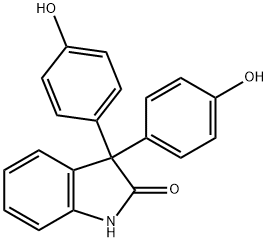|
|
| | 3,3-BIS(P-HYDROXYPHENYL)OXINDOLE Basic information |
| Product Name: | 3,3-BIS(P-HYDROXYPHENYL)OXINDOLE | | Synonyms: | 3,3-Bis(4-hydroxyphenyl)indoline-2-one;3,3-bis(4-hydroxyphenyl)-1H-indol-2-one;3,3-Bis(4-Hydroxsyphenyl)-2(3H)-Indolone;3,3-Bis(4-hydroxyphenyl)-1,3-dihydro-2H-indol-2-one;recolon;veripaque;3,3-bis(4-hydroxyphenyl)indolin-2-one;3,3-BIS(4-HYDROXYPHENYL)-2-INDOLINONE | | CAS: | 125-13-3 | | MF: | C20H15NO3 | | MW: | 317.34 | | EINECS: | 204-728-1 | | Product Categories: | | | Mol File: | 125-13-3.mol |  |
| | 3,3-BIS(P-HYDROXYPHENYL)OXINDOLE Chemical Properties |
| Melting point | 260-261 °C | | Boiling point | 562.9±50.0 °C(Predicted) | | density | 1.352±0.06 g/cm3(Predicted) | | storage temp. | Store at -20°C | | solubility | DMSO : ≥ 28 mg/mL (88.23 mM) | | form | Solid | | pka | 9.42±0.30(Predicted) | | color | White to off-white |
| | 3,3-BIS(P-HYDROXYPHENYL)OXINDOLE Usage And Synthesis |
| Uses | Oxyphenisatine is a diphenolic laxative and it’s prodrug Oxyphenisatine acetate inhibits the growth of the breast cancer cell lines MCF7, T47D, HS578T, and MDA-MB-468 by inducing multifaceted cell starvation response, which ultimately induces programmed cell death. | | Definition | ChEBI: Oxyphenisatine is a member of indoles. | | in vivo | Toxicity studies demonstrate that mice tolerate IP administration of OXY at 300 mg/kg once daily or 200 mg/kg twice daily. Administration of OXY at 300 mg/kg IP once daily for 10 days results in significantly smaller tumors from day 33 to day 52[1]. |
| | 3,3-BIS(P-HYDROXYPHENYL)OXINDOLE Preparation Products And Raw materials |
|